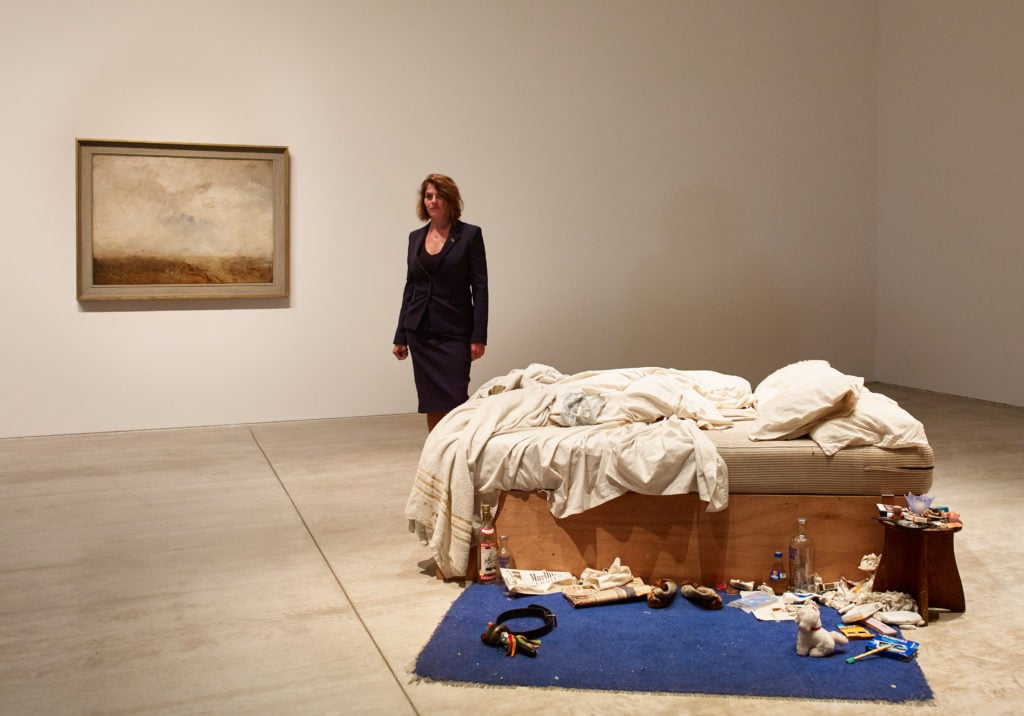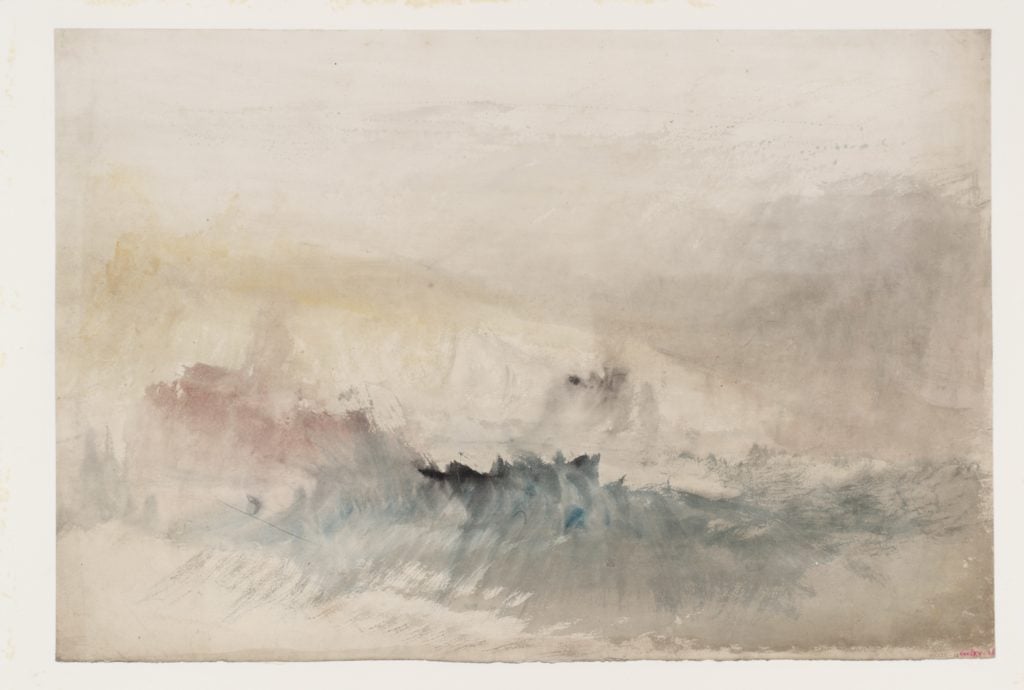On View
‘Turner Was a Really Raunchy Man’: Tracey Emin on Why Her Infamous ‘My Bed’ Is Really Like a J.M.W. Turner Painting
The unexpected connections have inspired a new show in Margate.

The unexpected connections have inspired a new show in Margate.

Naomi Rea

You can’t talk about Tracey Emin without talking about her bed.
First made—or rather, unmade—at a dingy Waterloo council flat in 1998, the iconic installation offers an uncompromising glimpse into the life of the then 35-year-old after a traumatic relationship breakdown. The confessional self-portrait of objects—complete with used condoms, cigarette butts, and empty vodka bottles—shocked the art world when it was featured in Tate Britain’s 1999 Turner Prize exhibition. So thoroughly have its daring and relatability altered the British public’s relationship with contemporary art in the years since, that few remember that the piece never actually won the prestigious award.
Yesterday, in Emin’s coastal hometown of Margate, Turner Contemporary kicked off its autumn season with the unveiling of a brand new installation of My Bed, nearly 20 years after it was first shown. The new installation places Emin’s work in context with that of another Margate legend, and the hosting gallery’s namesake, J.M.W. Turner.
Turner famously considered the skies in Margate to be “the loveliest in all of Europe,” and Emin has revealed plans to move back to the seaside town from London in July next year, once her new studio there is completed.
Since 2014, when it was bought at Christie’s for £2.5 million by a private collector, My Bed has been on long-term loan to Tate, showing at Tate Britain alongside works by Francis Bacon in 2015, and at Tate Liverpool alongside etchings by William Blake. For this installation, Emin selected 14 Turner works, three large oil paintings and eleven watercolors, depicting various seascapes and stormy skies that have never shown previously at the gallery.
The effect is breathtaking, and oddly cathartic. The clouds over Turner’s Rough Sea (c.1840-5) are uncannily echoed in the tangle of sheets over Emin’s bed, and the browns and yellows of the landscape are mirrored in the stained mattress, offering an extraordinary connection between the two distinct works.
Speaking to artnet News and other journalists in Margate ahead of the private view, here’s what Tracey Emin had to say about My Bed, the “magic carpet” that changed her life in so many ways.

Detail of Tracey Emin, My Bed (2017). Photo: Naomi Rea.
How has the installation changed in the 20 years since it was first shown?
It changes every time I install it. It gets older, and I get older, and all the objects and the bed get further and further away from me, from how I am now. I used the example, in there, about how the belt used to fit around my waist and now it actually fits around my thigh. So that gives you an idea about how much things change.
I don’t smoke, I don’t have sex, I don’t use contraceptives, I don’t have periods, I don’t wear small pale blue knickers that look like one of Turner’s clouds. I don’t make stains on the bed like that, like I used to, and if I did, I wouldn’t have a bed like that, the sheets would get washed immediately.
Every time I install it at each different place, my mood and how I’m feeling reflects in the bed. What I love about this installation is the Turner behind it. If you didn’t know, you’d think that I made the bed as a project: Here’s a Turner, now make a bed out of it. It’s uncanny. The pale blue knickers, that cloud, the sand banks with the sea, everything is just so similar.
I’m really pleased how Turner’s work and the bed relate to each other. I mean, we all know Turner was a really raunchy man, he was full of a lot of fecundity and action, and so am I, or used to be, so I think it’s quite nice. And also, with all his masculinity, he’s also actually incredibly feminine as well, the way he approached his painting, his temperament and his emotions were put in the open, which was quite rare at that time. The bed is very vulnerable and very open, and so are Turner’s paintings.

J.M.W. Turner, from Studies for Published ‘England and Wales’ Subjects, The Kent Coast from Folkestone Harbour to Dover, c.1829. Image: © Tate, London 2017.
Why do you think the installation still sparks such debate to this day?
I think because it caused such a fuss at the time, and people remember it, and because I’ve never seen anything like it before in my life in an art gallery, ever. So I think it still is seminal, it still has a presence, because almost everyone has been there, to a certain degree, and can relate to it. People respond to it in a very human way and take it far more seriously now than they did 20 years ago.
I don’t think people hate it anymore—I think they hated it because they hated contemporary art and they hated new ideas, or they hated to be exposed. Basically, I’m just exposing their own lives, in an even more extreme way. Everybody has had a stain in their life to some degree, I’m just saying it’s OK. It’s all right. And if people want to argue with me about that then they’ve got to sort out their own lives. Imagine fucking all the time, making love, and never making a stain! You’ve got a big problem in your bedroom.
Was there a decisive moment when you came to the idea that it was an art work?
No, it was immediate. I got out of bed and I looked at it and I just thought, “Wow.” I just saw it in a white space, I saw it out of that environment and, subconsciously, I saw myself out of that environment, and I saw a way for my future that wasn’t a failure, that wasn’t desperate. One that wasn’t suicidal, that wasn’t losing, that wasn’t alcoholic, anorexic, unloved.
Would you ever make another bed of you now?
No, it would be so boring! Can you imagine this Tracey’s bed? My bed now is immaculate, really nice. You know, a Ralph Lauren top and pillowcases and things, the nice throw over it.
I’m a different person. Of course I’m still partly the same but lots of things have changed. In my bed, in my sleeping partners, in my sleeping habits, and what I take to bed with me as well. I take a book to bed with me now, and a telephone. Not all that stuff.
Is there anything particularly different about installing it in your hometown?
Yeah. I’m going to be embarrassed tonight, all these old school friends who I never imagined seeing the internal world of my bed, or whatever, it definitely has a different relevance here. But I’m really pleased it’s in Margate, I think it’s good and I hope that lots of people come and see it here.
Are you working on anything now that is inspired by Margate?
No. I’m going to wait until I move back. Lots of people have asked me if I think my work will change and I think it will, probably. I worked for years with my childhood, using bad memories, and I really wonder, when I come back, whether all the good memories will come through. It will be really interesting, I think. It’s like coming full circle.
A couple of years ago you were talking about setting up an archive in London and opening it up to the public. Do you still plan on that, or will those plans move to Margate with you?
My archive will be in London, but my museum will be in Margate! When I die, hopefully there’ll be a museum here, which I think would be brilliant. You know: “Margate girl makes good.” Because you don’t need to have a Tracey Emin museum in London, do you? You can have it anywhere. I hope people will come to it. I’d much rather go out for the day in Margate. There’s too much happening in London.
“Tracey Emin: My Bed / JMW Turner” is showing at Turner Contemporary in Margate, England, until January 14, 2018.